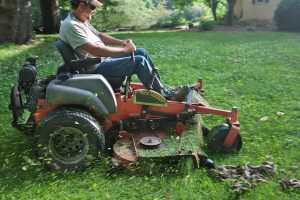Step By Step Guide On How To Fix a Lawn Mower That Won’t Start

Many homeowners pride themselves on maintaining a well-groomed lawn or garden. One vital tool for this task is a reliable lawn mower. But what happens when you pull the starter cord and it doesn’t roar to life? Knowing how to fix a lawn mower that won’t start can be crucial, saving time and money.
From issues with the fuel tank to faulty spark plugs, there are numerous reasons why lawnmowers might refuse to start. This article will guide you step by step so you can address common problems and get your mower back in action.
Essential Safety Precautions
Safety should be the utmost priority before diving into the nitty-gritty of lawn mower repairs. Lawnmowers, after all, are machinery with moving parts and flammable contents. So, consider the following tips:
Disconnect the Spark Plug Wire
This is the first and most crucial step. Always disconnect the spark plug wire before checking or touching any part of your lawn mower. It ensures that the lawn mower’s engine doesn’t accidentally start while you’re working on it, which could lead to serious injuries.
Work with a Cool Engine
The engine might be hot if you’ve attempted to start your mower several times. Allow it to cool down before you begin any work, especially when dealing with the fuel tank or filter.
Wear Appropriate Safety Gear
Don gloves and protective eyewear. This will safeguard your hands from sharp or greasy parts and your eyes from any unexpected sprays or debris.
Stabilize Your Mower
Place your lawn mower on a flat, stable surface so that any fuel or oil inside remains level, minimizing the risk of spills.
Check Visible Parts First
Before diving into the internal components, inspect the outer parts, like the air filter and spark plugs. A quick examination might reveal issues like clogged air filters or corroded spark plugs.
Basic Troubleshooting Options
When your lawn mower won’t start, it’s easy to feel frustrated. However, most common issues can be identified and fixed with some basic troubleshooting. Here’s a step-by-step guide to get you started:
Check the Fuel
The first step is to check that you have fresh fuel in the tank. Stale or contaminated fuel is a frequent culprit behind starting problems. If the fuel has been sitting in the mower for an extended period, it’s wise to drain it and replace it with fresh fuel.
Inspect the Spark Plug
A spark plug that’s corroded, fouled, or improperly gapped prevents the mower engine from starting. Remove and examine the plug; if it looks damaged, replace it. If it appears salvageable, clean it using a wire brush.
Examine the Air Filter
A dirty air filter can restrict airflow, making it hard for the mower to breathe and start. Remove the filter and give it a gentle tap to dislodge any loose debris. If it’s very dirty or soaked with oil or fuel, it’s best to replace it.
Look at the Fuel Filter and Line
Fuel should flow freely. If it doesn’t, the fuel filter might be clogged. Consider replacing it if it’s been a while. Additionally, inspect the fuel line for any kinks or blockages.
Clean the Mower Deck
Over time, grass clippings accumulate under the mower deck, causing potential issues. Cleaning the deck can sometimes help, especially if the clippings impede moving parts.
Other Advanced Troubleshooting Options
If the issue isn’t basic, you may need to dive deeper after the basic checks. Repairing lawn mowers can be intricate, but the following advanced steps might pinpoint the problem:
Deep Clean the Carburetor
A dirty carburetor can obstruct the flow of fuel. Detach the carburetor and spray the cleaner to remove gunk or deposits. If you’re comfortable, you can dismantle it for a thorough clean. Note that you should always refer to the manufacturer’s guidelines.
Moreover, the ignition system is vital for starting your mower. If there’s no spark when trying to start, this system could have an issue. Test the spark plug ignition with a tester to ensure it’s functioning correctly.
Apply Fresh Motor Oil
Occasionally, an engine might seize or become hard to start due to a lack of lubrication. So, check the oil level and consider draining and replacing the old oil with fresh motor oil. Sometimes, you may also wipe fresh motor oil onto moving parts for smooth movement.
Inspect Riding Mower Components
If you have a riding mower, additional components like the seat safety switch, brake/clutch, and battery can affect its ability to start. Hence, check to see if all these parts are in good condition and properly connected.
Check the Fuel System
Beyond the carburetor, other fuel system parts, like the fuel pump (if present), can cause starting issues. Confirm there’s fuel flow and that no parts are clogged or malfunctioning.
While these steps may help you identify the root cause, always refer to your mower’s manual and consult professionals if unsure.
When to Seek Professional Help

While many issues with lawn equipment can be addressed with a DIY spirit, certain problems require the expertise of a professional.
How can you recognize when to seek help to save time and money? We’ll take you through a few signs and situations where professional assistance may be warranted.
If you’ve exhausted the basic and advanced troubleshooting steps and your lawn mower still won’t start, it’s wise to seek expert help. Continuous failed attempts might further aggravate the problem.
Also, diagnosing a faulty fuel pump or a bad ignition coil can be tricky for the average mower owner. If you suspect issues with these components, especially in riding mowers, it’s best to consult a professional.
Issues like damaged pistons, internal engine problems, or a broken starter rope are intricate and require specialized tools and expertise.
What if your gas tank consistently has a problematic fuel mixture even after using fresh fuel and a stabilizer? In that case, you may be dealing with a more complex issue that requires a professional touch.
How To Maintain Your Lawn Mower Properly
Prevention is often better (and cheaper) for mower owners than cure. Regular maintenance ensures that your lawn equipment runs smoothly and prolongs its life. Now, these preventative steps will keep your mower in top shape:
- Regular Cleaning: After each use, especially when mowing tall grass, clean off the mower deck to remove grass clippings and other debris. That way, you can prevent buildup and potential future problems.
- Check the Fuel: Before refilling the gas tank, make sure the fuel is fresh. Storing fuel for prolonged periods leads to degradation, clogging the carburetor. If storing for long, use a fuel stabilizer to maintain fuel quality.
- Air and Fuel Filters: Regularly check and clean the air filter to aid optimal airflow. Similarly, inspect the fuel filter to avoid a clogged fuel line.
- Spark Plug Maintenance: Clean and inspect your spark plugs regularly. A bad ignition coil or faulty spark plug can lead to starting issues.
- Carburetor Care: Even with meticulous care, the carburetor may get gummed up. A carburetor cleaner can help prevent a clogged carburetor and boost smooth fuel flow.
- Avoid Mowing on Low Fuel: Running your mower on a nearly empty tank may trigger the intake of sediment-laden fuel, which can clog the fuel system. Thus, refill the tank when it reaches about 1/4 full.
Bottom Line
So, while you are preparing your soil or making your own compost, it’s essential to learn how to fix a lawn mower that won’t start as well. Whether addressing issues with the fuel tank or ensuring the air filter is clean, regular maintenance and timely troubleshooting keep lawnmowers running efficiently.
But when in doubt, seek professional guidance. This makes your lawn mower remain a dependable tool for years.
